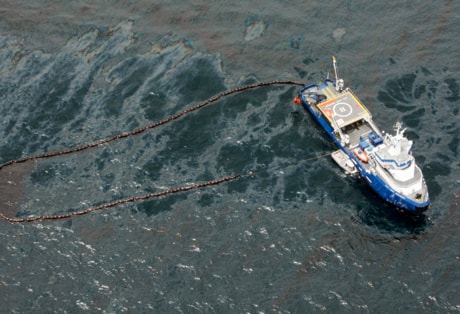NEW ORLEANS — Crews were using a robot submarine Sunday to try to stop an oil leak nearly two kilometres below the surface of the Gulf of Mexico, but officials said it would take at least another day before they knew whether the job was completed.
The Coast Guard said the oil spill was expected to stay 50 kilometres off the coast for the next three days, but officials are still keeping a watchful eye because the slick has the potential to threaten shores from Louisiana to Florida.
Officials said they were trying to stop the flow by using robot submarines to activate valves at the well head, but that would take 24 to 36 hours to complete. If that doesn’t work, crews are also planning to drill a relief well to cut off the flow — which could take several months.
What appeared to a manageable spill a couple of days ago after an oil rig exploded and sank off the Louisiana coast Tuesday, has now turned into a more serious environmental problem. The new leak was discovered Saturday, and as much as 1,000 barrels — or 160,000 litres — of oil is leaking each day, Coast Guard Rear Adm. Mary Landry said.
The new leak is troubling for the fragile ecosystem of shrimp, fish, birds and coral. Officials said it’s still too soon to say whether the sensitive habitat will be affected.
“What crude oil tends to do is float to surface and then under wave action it turns into what looks like chocolate mousse and sinks. It’s way too early to tell” the impact, said James Cowan, an oceanography and coastal sciences professor at Louisiana State University in Baton Rouge.
The initial spill occurred during the explosion on the Deepwater Horizon about 80 kilometres off the Louisiana coast. More than 100 workers safely escaped the platform, which is about the size of two football fields, but 11 workers have not been found and are presumed dead.
The explosion created a rainbow sheen of oil on the surface of the water for a couple of days. On Thursday, the rig sank, adding another twist to the accident.
Still, officials maintained that no more oil appeared to be leaking.
Severe weather rolled into the region Saturday, and crews had to suspend cleanup efforts. Then, officials offered up the grim news: the new leak had been found.
The sheen on the surface has grown, extending 30 kilometres by 30 kilometres Saturday — about 25 times larger than it appeared to be a day earlier, Landry said.
“This is a very serious spill, absolutely,” Landry said.
The leak is releasing about 160,000 litres a day. By comparison, Exxon Valdez spilled 40 million litres in Alaska’s Prince William Sound in 1989 — the worst oil spill in U.S. history.
“It has the potential to be pretty serious, but at 1,000 barrels a day, if it comes to the surface they’ll probably be able to contain it and vacuum it up,” Cowan said.
BP PLC, which leased the rig, has taken the lead in the cleanup, and crews have used robot submarines to try to stop the leak by closing valves on the well deep underwater. If that doesn’t work, the company could drill what’s called an intervention well to control the oil flow. But intervention drilling could take months.
“Over the next several days, we should determine which method is the best one to follow,” said Doug Suttles, chief operating officer for BP Exploration and Production.
BP said it has activated an extensive oil spill response, including the robot submarines, 700 workers, four planes and 32 vessels to mop up the spill and spray chemicals that will disperse the oil.
The Marine Spill Response Corp., an energy industry cleanup consortium, also brought in equipment. So far, crews have retrieved about 1,052 barrels of oily water.
Complicating efforts to stop the leak is the well head’s depth at 1,500 metres underwater, said Lars Herbst, the regional director for the Minerals Management Service. Leaks have been fixed at similar depths before, but the process is difficult, he said.
The sunken rig may have as much as 2.6 million litres of diesel on board, and an undetermined amount of oil has spilled from the rig itself. Suttles said the rig was “intact and secure” on the seabed about 400 metres from the well site.
The explosion appeared to be a blowout, in which natural gas or oil forces its way up a well pipe and smashes the equipment. But precisely what went wrong was under investigation.
The cause of Tuesday’s blast hasn’t been determined.
